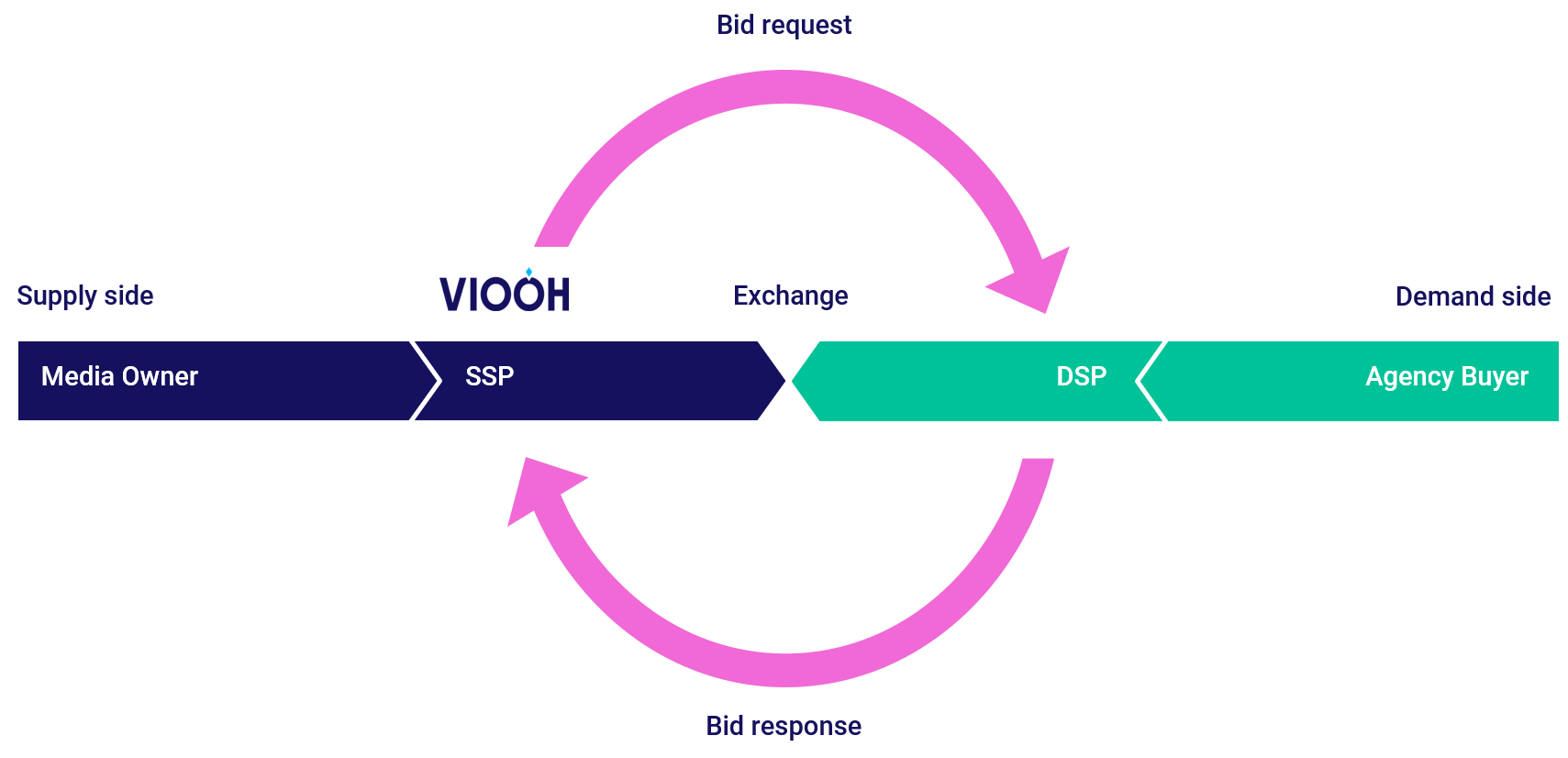JCDecaux, the company that calls itself “the number one outdoor advertising company worldwide,” made a splash in 2018, when it launched a programmatic digital out-of-home trading platform, VIOOH.
I recently interviewed Jean-Christophe Conti, CEO at VIOOH, to find out more about the company, its place in the programmatic DOOH market, and its plans.

N.U: What is VIOOH?
JC Conti:
VIOOH is a leading global digital out of home marketplace. Headquartered in London, VIOOH’s platform is a premium marketplace that makes OOH easily accessible to both buyers and sellers.
Through VIOOH, agencies and brands can add out-of-home components to omni-channel campaigns with the same ease as they buy online and mobile ad inventory.
VIOOH currently trades programmatically in 12 markets, with three more markets to follow in the coming months.
Why did you create VIOOH, what problem does it solve?
Thanks to rapid advancements in software and data, advertisers today expect media buying to be fast, easy, precise and accountable. By contrast, the process of buying OOH ad space has been lacking in those areas.
That is the problem VIOOH is designed to solve.
VIOOH offers an integrated platform that provides automation and programmatic trading in out-of-home advertising, similar to the process used in buying digital media.
What does programmatic approach bring to out-of-home advertising?
The benefits of programmatic OOH are varied and far-reaching. One example is the flexibility that programmatic enables to pause and restart campaigns at a moment’s notice.. Advertisers appreciated this flexibility during the pandemic, as regions moved in and out of local lockdowns.
In addition to facilitating the use of data for targeting purposes, programmatic OOH also enables targeting triggered by specific news, changes in weather, consumer movements and locations. This gives advertisers the ability to react to different variables in real time.
Another key benefit is that programmatic OOH can be combined with other channels such as mobile, as part of a broader marketing mix. Programmatic OOH uses geotargeting, movement tracking, retargeting and sequential messaging which makes it a valuable part of omnichannel campaigns.
Buyers also like the fact that DOOH offers a safe context for a brand’s reputation.
In programmatic OOH, transactions are transparent and accountable, and there’s little chance of ad fraud. At VIOOH for example, we don’t charge commission fees to the buy-side, so 100% of the budgets we receive go towards buying media.
Traditional OOH is known for being an effective branding medium. However, programmatic DOOH has recently proven to be effective in delivering tangible results, such as ad-driven actions (site/store visits, etc.) and purchase of advertised products.
Programmatic OOH therefore combines the advantages of a mass medium with precision targeting, flexibility, performance and data-driven reactivity.
What progress has VIOOH made since the launch?
It’s been going incredibly well. Ironically, the pandemic has accelerated the adoption of programmatic, as buyers needed more flexibility during the uncertain times.
In the past few months, we have been experiencing a huge bounce back already.
We currently have 32 Demand Side Platform (DSP) partnerships signed globally, with over 75 live iterations of these DSPs being enabled across several geographies, and more coming onboard all the time.
We saw a 35% to 50% month-on-month growth in the number of active programmatic campaigns since the beginning of the year with ad spend increasing at a very strong pace, despite many regions still being in lockdown.
Our platform offers access to premium out-of-home ad inventory in 12 markets globally including the UK, Germany, Australia and The US., and we are on course to reach 18 by the end of the year, including New Zealand and France at the end of Q2.
We launched VIOOH in the Australian market in April, and in Q1 alone, Australia was already one of our best-performing markets.
Another APAC region that offers huge potential is Hong Kong. We launched inventory in Hong Kong Airport at the end of 2020 with Verizon Media. We are now supporting the JCDecaux flight-data-activated ad campaigns targeting departing and arriving passengers.
We’re increasing Hong Kong island’s inventory for the metro as well as street furniture / cityscapes in the coming weeks. This will give us approximately 75% of the digital OOH inventory in Hong Kong. We do see Hong Kong as a prequel to our expansion in mainland China, where we have operated our Automation business since 2019.
There are a lot of programmatic DOOH platforms already. What are your relationships with them, if any?
VIOOH’s platform connects buyers and sellers in a premium marketplace. We need great relationships with the DSPs to deliver results for clients.
We’re partners with 32 DSPs globally, including The TradeDesk, Verizon Media, Vistar Media and Hivestack among others. In addition to that, we are integrated with regional and niche platforms such as Blip, TPS, and Ubimo.
Since we are a supply-side platform, our fees are 100% transparent, meaning we never charge buy-side commissions. We don’t try to serve multiple masters by becoming a DSP as well.
My perception has been that VIOOH’s supply consisted of JCDecaux’s inventory only. Is this true?
At the moment most of our inventory is JCDecaux-owned but we’re planning to expand it to include other media owners in the coming months. For instance, the inventory of Swiss DOOH ad operator APG|SGA can now be bought programmatically through VIOOH. (See more about APG|SGA at https://www.apgsga.ch/en/)
Can we say that VIOOH is going to be a cross-network (multi-network) DOOH SSP?
Yes.
What is the current state of the programmatic DOOH market, from your perspective?
Each year, VIOOH undertakes its State of the Nation research to answer this very question. Our most recent reports looked at the sector in the US, UK, Germany (October 2020) and Hong Kong (April 2021). We asked media agency and brand executives for their expectations of programmatic DOOH, and the results showed that strong and continued growth is predicted for the industry over the next 18 months.
There’s no doubt that the pandemic and the ensuing lockdowns have had a huge impact on the out of home sector across the globe, but it’s encouraging to see signs of growth as different regions begin to unlock.
The continued uncertainty has also highlighted to advertisers the benefits of programmatic OOH, which offers the ability to pause, pivot and optimize campaigns at a moment’s notice. The pandemic has accelerated the digitalization of OOH and I expect this trend to continue as the industry recovers.
What are the obstacles preventing advertisers from using programmatic DOOH more? How do you think these obstacles should be eliminated and how soon can it be done?
Our research has shown a need for education on the benefits of programmatic OOH, as well as a need for a more aligned approach to measurement are currently some of the biggest barriers to the adoption of programmatic OOH. Understanding the unique benefits that it offers, which include its ability to align with mobile and other channels, its ability to achieve both brand and performance goals, and its flexibility and targeting, is critical to its wider adoption. Our research in the US, UK and Germany found that only 56% of those surveyed felt they fully understood programmatic OOH and its benefits.
In terms of measurement, our research uncovered a lack of consensus around measurement solutions, although performance-based metrics were considered to be the most effective. At VIOOH we believe that standardized measurement and attribution are vital for the sector’s continued growth and are working closely with industry bodies to establish such standards for programmatic OOH.
What are your plans for VIOOH for 2021 and 2022?
Our recent launch in Australia brings the total number of markets in which our platform trades programmatically to 12 and our ambition is to grow this number to 18 by the end of this year.
We want to work with more media owners and DSPs to give advertisers the best possible outcomes for their campaigns. We’re also keen to encourage media buyers to include programmatic digital out of home as part of every omnichannel campaign. A campaign is always more effective when it can be planned, targeted and optimised across all channels in real-time whilst the campaign is live.
We’re also committed to delivering a standardised measurement approach that supports dynamic content, reactive creative, data-driven triggers and competitive pricing, with transparency. The recent IAB UK Glossary is the first step on this road but there’s much more work to be done. We’d love to see gold standard accreditation for programmatic digital out of home, that incorporates the nuances of OOH and allows for DOOH to be evaluated alongside other digital channels.
Programmatic digital out of home is still in its infancy and has huge potential to deliver valuable results for brands – and I’m very proud to be leading the way for the advertising industry.
For more information visit: www.viooh.com
